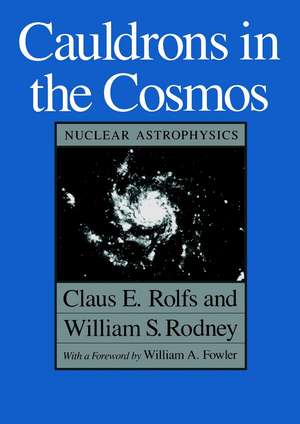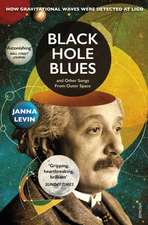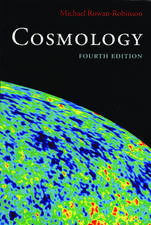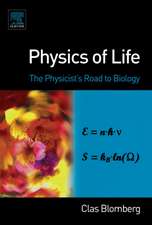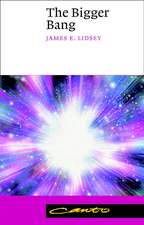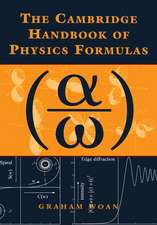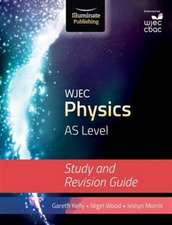Cauldrons in the Cosmos: Nuclear Astrophysics: Theoretical Astrophysics
Autor Claus E. Rolfs, William S. Rodneyen Limba Engleză Paperback – 16 feb 2006
Nuclear astrophysics is, in essence, a science that attempts to understand and explain the physical universe beyond the Earth by studying its smallest particles. Cauldrons in the Cosmos, by Claus E. Rolfs and William S. Rodney, serves as a basic introduction to these endeavors. From the major discoveries in the field to a discussion of the makeup of stars to an explanation of standard lab techniques, this text provides students and scientists alike a thorough and fascinating survey of the accomplishments, goals, and methods of nuclear astrophysics. A classic in its field, Cauldrons in the Cosmos will surely remain an important reference in nuclear astrophysics for years to come.
"One could not wish for a better account of the current state of knowledge (and uncertainty) about nuclear reactions in stars."—B. E. J. Pagel, Nature
"Written in an informal style that those uninitiated into the jargon of nuclear astrophysics and astronomy will find readable and illuminating. . . . A useful and long-awaited introduction to nuclear astrophysics."—G. J. Mathews, Science
"One could not wish for a better account of the current state of knowledge (and uncertainty) about nuclear reactions in stars."—B. E. J. Pagel, Nature
"Written in an informal style that those uninitiated into the jargon of nuclear astrophysics and astronomy will find readable and illuminating. . . . A useful and long-awaited introduction to nuclear astrophysics."—G. J. Mathews, Science
Preț: 478.15 lei
Nou
Puncte Express: 717
Preț estimativ în valută:
91.51€ • 94.53$ • 76.16£
91.51€ • 94.53$ • 76.16£
Carte tipărită la comandă
Livrare economică 25 martie-08 aprilie
Preluare comenzi: 021 569.72.76
Specificații
ISBN-13: 9780226724577
ISBN-10: 0226724573
Pagini: 580
Ilustrații: 14 halftones, 198 line drawings
Dimensiuni: 178 x 254 x 38 mm
Greutate: 0.89 kg
Ediția:1
Editura: University of Chicago Press
Colecția University of Chicago Press
Seria Theoretical Astrophysics
ISBN-10: 0226724573
Pagini: 580
Ilustrații: 14 halftones, 198 line drawings
Dimensiuni: 178 x 254 x 38 mm
Greutate: 0.89 kg
Ediția:1
Editura: University of Chicago Press
Colecția University of Chicago Press
Seria Theoretical Astrophysics
Notă biografică
Claus E. Rolfs is professor of physics at the University of Münster. William S. Rodney is the Adjunct Research Professor of Physics at Georgetown University and a Guggenheim fellow.
Cuprins
Foreword
Preface
1 Astronomy-Observing the Universe
Preface
1 Astronomy-Observing the Universe
1.1 Observational Techniques
1.1.1 Optical Astronomy
1.1.2 Radio Astronomy
1.1.3 Space Astronomy
1.1.2 Radio Astronomy
1.1.3 Space Astronomy
1.2 Observed Structures in the Cosmos
1.2.1 The Solar System
1.2.2 Normal Stars and Clusters of Stars
1.2.3 Unusual Stars
1.2.3.1 Eclipsing Stars
1.2.3.2 Eruptive Stars
1.2.3.3 Pulsating Stars
1.2.3.4 Planetary Nebulae
1.2.3.5 X-Ray Stars
1.2.4 Our Galaxy-the Milky Way
1.2.5 Galaxies and Clusters of Galaxies
1.2.6 Radio Galaxies and Quasars
1.2.7 The Universe
1.2.2 Normal Stars and Clusters of Stars
1.2.3 Unusual Stars
1.2.3.1 Eclipsing Stars
1.2.3.2 Eruptive Stars
1.2.3.3 Pulsating Stars
1.2.3.4 Planetary Nebulae
1.2.3.5 X-Ray Stars
1.2.4 Our Galaxy-the Milky Way
1.2.5 Galaxies and Clusters of Galaxies
1.2.6 Radio Galaxies and Quasars
1.2.7 The Universe
1.3 Selected General Properties of the Universe
1.3.1 Observed Abundances of the Elements
1.3.2 The Hertzsprung-Russell Diagram
1.3.3 Mass-Luminosity Relation of Main-Sequence Stars
1.3.4 The Expansion of the Universe and Hubble's Law
1.3.5 The Universal Background Radiation
1.3.6 Quasars as Probes of the Distant Universe
1.3.2 The Hertzsprung-Russell Diagram
1.3.3 Mass-Luminosity Relation of Main-Sequence Stars
1.3.4 The Expansion of the Universe and Hubble's Law
1.3.5 The Universal Background Radiation
1.3.6 Quasars as Probes of the Distant Universe
2 Astrophysics-Explaining the Universe
2.1 Big-Bang Cosmology
2.1.1 Standard Cosmological Models
2.1.2 Basic Physics and Dynamics ofthe Standard Big-Bang Model
2.1.3 Evolution of the Early Universe
2.1.4 Versions of the Big-Bang Universe
2.1.5 The Beginning of the Standard Universe
2.1.6 Matter-Antimatter Asymmetry and the Origin of Baryons
2.1.7 The Inflationary Universe
2.1.2 Basic Physics and Dynamics ofthe Standard Big-Bang Model
2.1.3 Evolution of the Early Universe
2.1.4 Versions of the Big-Bang Universe
2.1.5 The Beginning of the Standard Universe
2.1.6 Matter-Antimatter Asymmetry and the Origin of Baryons
2.1.7 The Inflationary Universe
2.2 Nucleosynthesis in the Early Universe
2.2.1 The Quest for Light-Element Creation
2.2.2 Ashes of the Primeval Big Bang
2.2.3 Implications of Primordial Nucleosynthesis
2.2.2 Ashes of the Primeval Big Bang
2.2.3 Implications of Primordial Nucleosynthesis
2.3 The Formation of Galaxies
2.4 Physical State of the Stellar Interior
2.4 Physical State of the Stellar Interior
2.4.1 Hydrostatic Equilibrium
2.4.2 Equation of State of Normal Stars
2.4.3 Effects of the Chemical Composition
2.4.4 Stored Energy of a Star
2.4.5 Thermal Equilibrium
2.4.6 Energy Transport Mechanisms
2.4.7 Magnitude of Stellar Luminosities
2.4.8 The Mass-Luminosity Relation and Stellar Lifetimes
2.4.9 Stellar Stability
2.4.10 Equation of State for Degenerate Matter
2.4.11 Theory of White Dwarfs
2.4.12 Neutron Stars
2.4.13 Black Holes
2.4.2 Equation of State of Normal Stars
2.4.3 Effects of the Chemical Composition
2.4.4 Stored Energy of a Star
2.4.5 Thermal Equilibrium
2.4.6 Energy Transport Mechanisms
2.4.7 Magnitude of Stellar Luminosities
2.4.8 The Mass-Luminosity Relation and Stellar Lifetimes
2.4.9 Stellar Stability
2.4.10 Equation of State for Degenerate Matter
2.4.11 Theory of White Dwarfs
2.4.12 Neutron Stars
2.4.13 Black Holes
2.5 The Lives of the Stars
2.5.1 Birth of Stars in Interstellar Clouds
2.5.2 From Nebulae to the Main Sequence
2.5.3 Main-Sequence Stars
2.5.4 Endpoints of Stellar Evolution
2.5.2 From Nebulae to the Main Sequence
2.5.3 Main-Sequence Stars
2.5.4 Endpoints of Stellar Evolution
2.6 The Origin of the Chemical Elements
2.7 Evolution of Binary Systems
2.7 Evolution of Binary Systems
2.7.1 Effects of Gravity on Stars in Contact
2.7.2 The Nova Phenomenon
2.7.3 X-Ray Stars
2.7.4 Supernovae of Type I
2.7.2 The Nova Phenomenon
2.7.3 X-Ray Stars
2.7.4 Supernovae of Type I
3 Definitions and General Characteristics of Thermonuclear Reactions
3.1 Source of Nuclear Energy
3.2 Cross Section
3.3 Stellar Reaction Rate
3.4 Mean Lifetime
3.5 Maxwell-Boltzmann Velocity Distribution
3.6 Inverse Reactions
3.7 Energy Production
3.2 Cross Section
3.3 Stellar Reaction Rate
3.4 Mean Lifetime
3.5 Maxwell-Boltzmann Velocity Distribution
3.6 Inverse Reactions
3.7 Energy Production
4 Determination of Stellar Reaction Rates
4.1 Neutron-Induced Nonresonant Reactions
4.2 Charged-Particle-Induced Nonresonant Reactions
4.3 Reactions through Isolated and Narrow Resonances
4.4 Reactions through Broad Resonances
4.5 Subthreshold Resonances
4.6 Summary
4.2 Charged-Particle-Induced Nonresonant Reactions
4.3 Reactions through Isolated and Narrow Resonances
4.4 Reactions through Broad Resonances
4.5 Subthreshold Resonances
4.6 Summary
5 Laboratory Equipment and Techniques in Nuclear Astrophysics
5.1 Ion Beams
5.1.1 Ion Sources and Beam Formation
5.1.1.1 Electron-Impact Ion Source
5.1.1.2 Arc-Discharge Ion Source
5.1.1.3 Duo-Plasmatron Ion Source
5.1.1.4 Penning Ion Source
5.1.1.5 RF Ion Source
5.1.1.6 Hollow-Cathode Ion Source
5.1.1.7 Sputter Ion source
5.1.1.2 Arc-Discharge Ion Source
5.1.1.3 Duo-Plasmatron Ion Source
5.1.1.4 Penning Ion Source
5.1.1.5 RF Ion Source
5.1.1.6 Hollow-Cathode Ion Source
5.1.1.7 Sputter Ion source
5.1.2 Accelerators
5.1.2.1 Van de Graaff Accelerator
5.1.2.2 Cockcroft-Walton Accelerator
5.1.2.3 Dynamitron Accelerator
5.1.2.4 Tandem Accelerator
5.1.2.5 Cyclotron
5.1.2.6 Linac
5.1.2.2 Cockcroft-Walton Accelerator
5.1.2.3 Dynamitron Accelerator
5.1.2.4 Tandem Accelerator
5.1.2.5 Cyclotron
5.1.2.6 Linac
5.1.3 Beam Transport System
5.1.4 Analysis of Beam Properties
5.1.5 Beam Integration
5.1.4 Analysis of Beam Properties
5.1.5 Beam Integration
5.2 Target Features and Target Chambers
5.2.1 Solid Targets
5.2.2 Gas Targets
5.2.2 Gas Targets
5.3 Detectors
5.3.1 Detectors for Heavy Charged Particles
5.3.2 Neutron Detectors
5.3.3 Gamma-Ray Detectors
5.3.2 Neutron Detectors
5.3.3 Gamma-Ray Detectors
5.4 Detection Techniques
5.4.1 Electronics and Data Acquisition
5.4.2 Detection of Reaction Products
5.4.3 Activity Method
5.4.4 Time-of-Flight Techniques
5.4.2 Detection of Reaction Products
5.4.3 Activity Method
5.4.4 Time-of-Flight Techniques
5.5 Experimental Procedures and Data Reduction
5.5.1 Cross Section and Yield of Nuclear Reactions
5.5.2 Factors Affecting the Reaction Yield
5.5.3 Reaction Yield and Experimental Observation
5.5.4 Measurement of Excitation Functions
5.5.5 Measurement of Angular Distributions
5.5.6 Absolute Cross Section and Resonance Strength
5.5.2 Factors Affecting the Reaction Yield
5.5.3 Reaction Yield and Experimental Observation
5.5.4 Measurement of Excitation Functions
5.5.5 Measurement of Angular Distributions
5.5.6 Absolute Cross Section and Resonance Strength
5.6 Some Future Techniques
5.6.1 Detection of Recoil Nuclei in Capture Reactions
5.6.2 Accelerator Mass Spectrometry
5.6.3 Radioactive Ion Beams
5.6.4 Storage Rings
5.6.2 Accelerator Mass Spectrometry
5.6.3 Radioactive Ion Beams
5.6.4 Storage Rings
6 Hydrogen Burning
6.1 The Proton-Proton Chain
6.1.1 Theoretical Cross Section for the p + p Reaction
6.1.2 Burning of Deuterium
6.1.3 Burning of 3He and Completion of the p-p-I Chain
6.1.4 Stellar Fates of 7Be
6.1.5 The Three p-p Chains
6.1.6 Laboratory Approach to p-p Chain Reactions
6.1.2 Burning of Deuterium
6.1.3 Burning of 3He and Completion of the p-p-I Chain
6.1.4 Stellar Fates of 7Be
6.1.5 The Three p-p Chains
6.1.6 Laboratory Approach to p-p Chain Reactions
6.1.6.1 The d(p, y)3He Reaction
6.1.6.2 The 3He(3He, 2p)4He Reaction
6.1.6.3 The Capture Reaction 3He(a, y)7Be
6.1.6.4 Termination of the p-p Chains II and III
6.1.6.5 Processes Involving the Weak Force
6.1.6.2 The 3He(3He, 2p)4He Reaction
6.1.6.3 The Capture Reaction 3He(a, y)7Be
6.1.6.4 Termination of the p-p Chains II and III
6.1.6.5 Processes Involving the Weak Force
6.2 The CNO Cycles
6.2.1 The CN Cycle
6.2.2 The CNO Bi-cycle
6.2.3 The Discovery of Additional Cycles
6.2.4 Consequences of the CNO Cycles
6.2.2 The CNO Bi-cycle
6.2.3 The Discovery of Additional Cycles
6.2.4 Consequences of the CNO Cycles
6.3 Other Cycles
6.3.1 The NeNa Cycle
6.3.2 The MgAI Cycle
6.3.3 Elemental Abundances
6.3.2 The MgAI Cycle
6.3.3 Elemental Abundances
7 Helium Burning
7.1 The Detour around the Mass Stability Gaps, and the Creation of 12C
7.2 The Survival of 12C in Red Giants
7.2 The Survival of 12C in Red Giants
7.2.1 Expected Properties of the 12C(a, y)16O Reaction
7.2.2 Measurements of the 12C(a, y) 16O Reaction
7.2.3 Elemental Abundances
7.2.2 Measurements of the 12C(a, y) 16O Reaction
7.2.3 Elemental Abundances
7.3 The Blocking of Quiescent Helium Burning
7.4 Other Helium-Burning Reactions
7.5 Perspectives on Helium-Burning Reactions
7.4 Other Helium-Burning Reactions
7.5 Perspectives on Helium-Burning Reactions
8 Advanced and Explosive Burning
8.1 Quiescent Heavy-Ion Burning
8.1.1 Absorption under the Barrier
8.1.2 Intermediate Structure in the Continuum
8.1.3 Gross Energy Dependence
8.1.2 Intermediate Structure in the Continuum
8.1.3 Gross Energy Dependence
8.2 Silicon Burning
8.2.1 The Photodisintegration Era
8.2.2 Photodisintegration in Silicon Burning
8.2.3 The Nuclear Physics of Silicon Burning
8.2.2 Photodisintegration in Silicon Burning
8.2.3 The Nuclear Physics of Silicon Burning
8.3 The Final Bursts of Nucleosynthesis in Massive Stars
8.3.1 The Inner Structure of a Presupernova Star
8.3.2 Theories of Supernovae of Type II
8.3.3 Explosive Nucleosynthesis
8.3.4 Nuclear Physics Aspects of Explosive Burning
8.3.2 Theories of Supernovae of Type II
8.3.3 Explosive Nucleosynthesis
8.3.4 Nuclear Physics Aspects of Explosive Burning
9 Nucleosynthesis beyond Iron
9.1 The Quest for the Origin of the Trans-Iron Elements
9.2 Neutron-Capture Cross Sections
9.3 Basic Mechanisms for Nucleosynthesis beyond Iron
9.4 The s-Process
9.5 The r-Process
9.6 Nucleocosmochronology-the Age of the Chemical Elements
9.2 Neutron-Capture Cross Sections
9.3 Basic Mechanisms for Nucleosynthesis beyond Iron
9.4 The s-Process
9.5 The r-Process
9.6 Nucleocosmochronology-the Age of the Chemical Elements
10 Miscellaneous Topics
10.1 The Case of the Missing Solar Neutrinos
10.1.1 The Quest
10.1.2 The Standard Solar Model
10.1.3 Detection of Solar Neutrinos
10.1.4 Suggested Solutions
10.1.2 The Standard Solar Model
10.1.3 Detection of Solar Neutrinos
10.1.4 Suggested Solutions
10.2 Isotopic Anomalies and the Early History of the Solar System
10.2.1 The Homogeneous Isotopic Composition
10.2.2 The Discovery of Isotopic Anomalies
10.2.3 Oxygen Isotopic Anomalies
10.2.4 Magnesium and the Discovery of Extinct 26A1
10.2.5 Neon and Extinct 22Na
10.2.6 Conclusions
10.2.2 The Discovery of Isotopic Anomalies
10.2.3 Oxygen Isotopic Anomalies
10.2.4 Magnesium and the Discovery of Extinct 26A1
10.2.5 Neon and Extinct 22Na
10.2.6 Conclusions
10.3 The Origin of the Light Elements Li, Be, and B
10.3.1 The Problem
10.3.2 Properties of Galactic Cosmic Rays
10.3.3 Production of Li, Be, and B via Spallation
10.3.2 Properties of Galactic Cosmic Rays
10.3.3 Production of Li, Be, and B via Spallation
Epilogue
Appendix: Notation and Units
References
Index
Appendix: Notation and Units
References
Index
